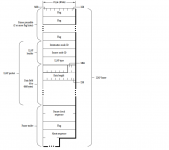More information:
Localtalk uses 230.4KBps Biphase space encoding (FM0 encoding) over the RS-422/RS-485 differential pair.
Known as SDLC or Synchronous Data Link Control.
Bit timing is 4.34uS. a 1 bit is a full state for each bit period. It will either be high, or low for the entire 4.34uS duration of the bit timing.
A 0 bit produces a high/low transition exactly half-bit timing, or double the frequency of 1.
Bi-Phase Space
Level change occurs at the beginning of every bit period
"One" is represented by no midbit level change
"Zero" is represented by a midbit level change.
This is why LLAP uses Synchronization via the Flag Bytes, 0x7E.
You have to setup a timer in the AVR using 4.34uS data bit timings. Problem is, You dont know when the "start" condition of a byte occurs. So to get around that, they used the flag byte to synchronize when the first bit of a byte occured.
The easiest thing to do is setup the AVR for pin-change interrupt. Use the timer to keep track of the periods between transitions, then you will know when 1 bits and 0 bits occur. Then you will use the 0x7E to keep track of start/stop of databytes.
For example, when the pin-change interrupt occurs, setup the timer at 0. it will count until the next transition. If the timer counted 4.34uS, that was a 1 bit. if it counted 2.17uS, it was a 0 bit. The first 8 bits received are stored. and checked against 0x7E. Of course it wont be correct because your not synchronized. Thats why the Flag Byte is send multiple times. Once you are able to get enough bits received, you can figure out where your start bit is supposed to be. Fix your start position in the code, and boom now your synched. Now of course youll have to correct in code for double transitions otherwise youll end up with false bits and more bits than you need. hehe.
Simple.


